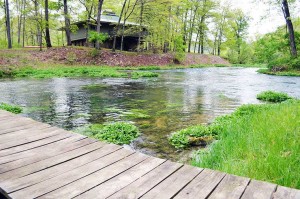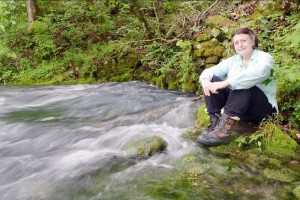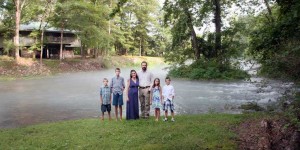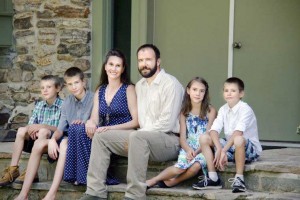Rainbow Springs is Ozark County’s own ‘Garden of Eden’

Posted: Sunday, August 9, 2015 12:00 am
By Tom Uhlenbrock MO Department of Natural Resources
Dorothy Carpenter describes Rainbow Springs as “a Garden of Eden.”
It’s fair to say the spectacular setting is one of the prettiest pieces of paradise the Missouri Ozarks has to offer.
The spring, and thousands of wooded acres around it, has been privately owned and preserved by Carpenter’s St. Louis-based family for more than a century.
Rainbow Springs is the best-kept secret among Missouri’s natural wonders, but that is about to change. A historic fishing lodge overlooking the spring is now available for nightly rental.
Rainbow Springs is the third largest in a state that boasts several impressive springs. The average daily flow is more than 100 million gallons of crystalline water that empties into the North Fork of the White River. Wet weather can increase the output to more than 180 million gallons.
The water bursts from the base of a wooded bluff with a boil that rises one to two feet above the surface in a rocky grotto green with ferns, mosses and watercress.
Rainbow Springs originally was called Double Spring because the water splits into two branches as it leaves the pool, entering the river at two spots about a mile apart.
The rushing water doubles the flow of the North Fork, a pristine floating and trout fishing stream in south-central Missouri, some 25 miles from the Arkansas border.

A strip of bottomland forest perhaps 100 yards wide sits between the spring and the river. The spring branches flow around the land on their way to the river, forming an island.
The only structure on that island is Rainbow Springs Lodge, which was built in the mid-1960s. The lodge has four bedrooms and five bathrooms, and a distinct design with wide eaves on the roof and a stone-and-wood fireplace that soars through an atrium in the interior.
“It’s a really well thought out architectural gem,” Carpenter said. “The architect was Barry Evans. He was definitely of the Bill Bernoudy-Frank Lloyd Wright ilk.”
Carpenter, who is 65 and without children, owns the lodge with her sister and a cousin. This May, they put it up for nightly rental through River of Life Farm, a resort a mile of so downriver.
Myron and Ann McKee, owners of the popular resort, are known for their “treehouse” cabins, some by the water’s edge and others hidden higher up the hillside in the secluded river valley.
“The only problem with private ownership is you don’t have public access – Myron’s involvement solves that,” Carpenter said. “We want to make the lodge self-sustaining and let people experience Rainbow Springs the way my family has.”

Proposed for development
Carpenter’s recounting of the family history at Rainbow Springs began with what she called “the monster on the wall.”
She referred to a framed surveyor’s drawing for a proposal titled “Rainbow Springs Resort and Fisheries Inc.,” dated Aug. 10, 1927. It showed the forest around the spring subdivided into hundreds of small plots, with a hotel and garage in the middle. A road led to the “golf links.”
The company stocked the spring with rainbow trout and changed its name from Double Spring to Rainbow Springs.
Carpenter explained that in the early 1920s, people were seeking a summer escape from the soot and heat of St. Louis. Riverside clubhouse communities like Times Beach and Castlewood sprang up in St. Louis County. Rainbow Springs was on the drawing board.
In 1928, her grandfather, Birch Oliver Mahaffey of St. Louis, discovered the project and bought a fifth of the company and some 6,000 acres surrounding the spring.
“I believe from reading his letters that he wanted to gain as much control of the spring as he could,” Carpenter said. “The Depression gave him the opportunity to buy out the rest of the company and halt all development plans on the property. From then on, he strove to preserve its natural state.”
A comfortable place
Mahaffey had four daughters, and three of them hired Evans, the architect, to design a lodge for their families.
“They wanted to be able to see the spring from the lodge at all times of the day,” Carpenter said. “So they built it directly across from the spring, with glass corner windows for seeing every angle of the spring branches.”
The house was done in the mid-century modern style, with ingenious touches. The fireplace hearth is of poured and polished concrete wide enough to sit around. The chimney is fronted by slanting wood strips wide enough for storing fly-fishing rods.
Mahaffey long had the idea of cooling the lodge with the 55-degree spring water, and Evans attempted to do it, with little success. Myron McKee of River of Life has preserved the lodge’s historic furniture and artifacts, although he did update the heating and cooling system.

Shelby and Sheree Nold and their children, from left, Cade, 8; Gunnison, 13; Autumn, 10; and Joshua (twin brother of Cade), 8, recently moved from their home near Fair Play into the caretaker’s house next to Rainbow Springs Lodge. They will be assisting the McKees in keeping it maintained and ready for resort guests. The Nolds operate as caretakers through their Christian-based nonprofit organization, Majestic Outdoors (majesticoutdoors.com).
A stone patio is off the first floor, and a deck is on the second floor, both within sight of the spring, which is reached by a sturdy wood foot bridge. Open the bedroom windows at night and the sound of the water tumbling along fills the rooms.
“It’s a very rugged house – people came in with their waders – the oak furniture is as tough as nails,” Carpenter said. “All of us had different ideas, and the architect interviewed us and dealt with completely diverse uses for the place. I was 18 at the time and wanted space to throw 30 sleeping bags for my friends.”
Trout, eagles and hellbenders
The bottom floor of the lodge has a kitchen, utility rooms, half bath and a large open living and dining room with two sets of sofas. The second floor has four spacious bedrooms, each with two single beds and a full bath.
The second floor has a balcony looking down on the fireplace and first floor. The balcony was made wide enough to hold extra beds, or sleeping bags. Cots are provided, bringing the maximum occupancy to 14.
The nightly rental price, with a two-night minimum, is $850 for up to eight people. Each additional adult is $87.50 a night; children younger than 12 are $43.75. For more information, visit RiverOfLifeFarm.com.
Fed by springs and protected by national forest for the top two-thirds of its 50 miles, the North Fork has one of the largest self-sustaining wild rainbow trout populations in the Midwest.
Resident bald eagles live in the valley, and the river was chosen by wildlife researchers for a restocking program of endangered Ozark hellbenders, a large, aquatic salamander.
The family maintains control of Rainbow Springs and some 1,400 acres of land around it. “Preserving the forests of the watershed ensures protection of the spring’s purity and the North Fork’s incredible scenic beauty,” Carpenter said.
Arrowheads and other archaeological evidence indicated the spring was visited by the first Americans. In later days, Jesuits used the lodge for spiritual retreats.
“I can’t let the spring be desecrated – it’s a special place,” she said. “The Indians felt it was sacred. I feel that way, too.”
